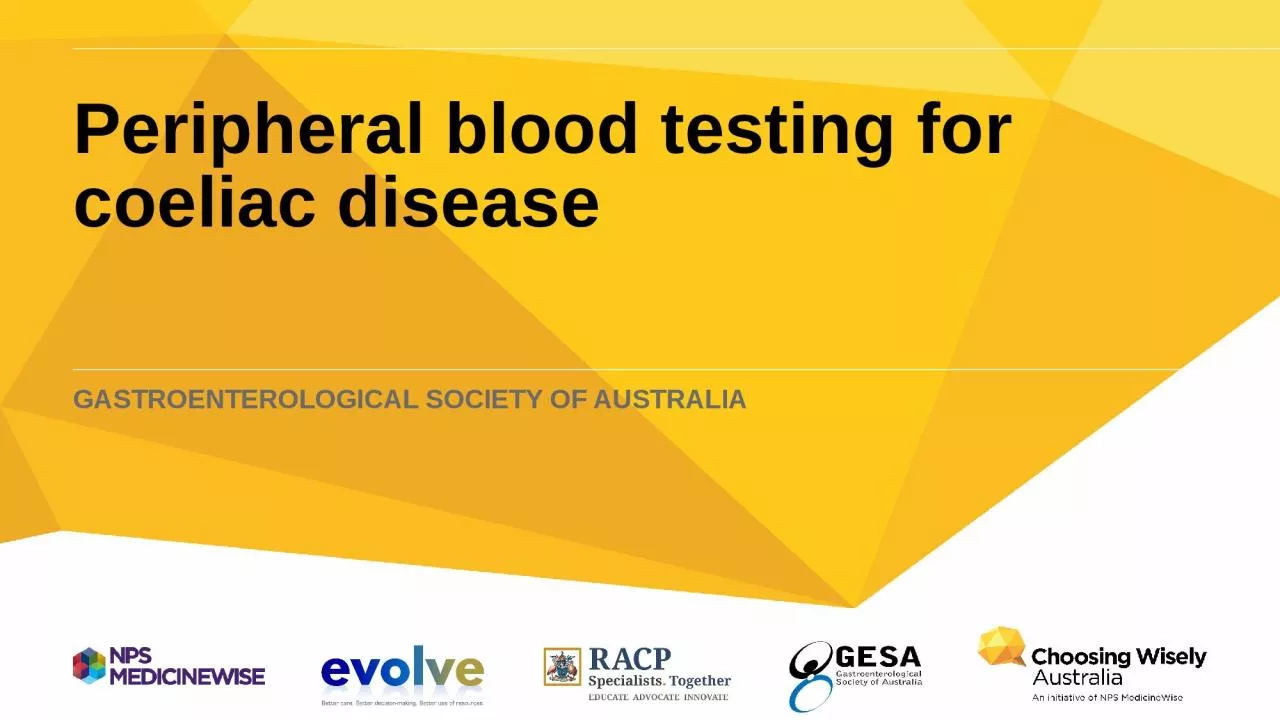

Gastroenterological Society of Australia Jaswinder Patient medical history PMHx 25yearold female north Indian background Only medication oral contraceptive pill for menorrhagia control for 7 years ID: 933440
Download Presentation The PPT/PDF document "Peripheral blood testing for coeliac dis..." is the property of its rightful owner. Permission is granted to download and print the materials on this web site for personal, non-commercial use only, and to display it on your personal computer provided you do not modify the materials and that you retain all copyright notices contained in the materials. By downloading content from our website, you accept the terms of this agreement.
Slide1
Peripheral blood testing for coeliac disease
Gastroenterological Society of Australia
Slide2Jaswinder
Patient medical history (
PMHx
)
25-year-old female, north Indian background
Only medication: oral contraceptive pill (for menorrhagia control) for 7 years
Allergic rhinitis on PRN antihistamines
Works as accountant
Vegetarian but otherwise no dietary restrictions
No relevant family history of gastrointestinal disorders
Symptoms
Three years of abdominal cramps, bloating,
diarrhoea
Triggered by wheat and dairy
Increasing fatigue in the last year
Slide3Jaswinder
Tests / Investigations
Full blood count= haemoglobin 105 g/L (normal =110 - 140 g/L), MCV 78
fL
(normal 80
fL - 95 fL)Renal and liver function tests normalThyroid function tests normalStool tests= no bacterial or parasite infectionsFerritin 10 μg/L (normal 20 μg/L - 160 μg/L)
Examination
Blood pressure, heart rate, temperature, respiratory rate within normal limits
Weight 49 kg, height 1.67 cm, BMI 17.6 kg/m2
Mildly tender epigastric area on palpation
No abdominal
organomegaly
or ascites
Slide4What blood tests are suitable next steps to investigate for possible coeliac disease?
Serology: anti-tissue transglutaminase IgA
Serology: anti-deamidated gliadin IgG
HLA-DQ2 and HLA-DQ8 genotyping
Total IgA levels
Slide5What blood tests are suitable next steps to investigate for possible coeliac disease?
Serology: anti-tissue transglutaminase IgA
Serology: anti-deamidated gliadin IgG
HLA-DQ2 and HLA-DQ8 genotyping
Total IgA levels
Slide6Choosing Wisely Australia Recommendation
Do not undertake genetic testing for coeliac genes as a screening test for coeliac disease
Gastroenterological Society of Australia
Slide7What is best practice?
Testing for coeliac disease should initially be serological testing (following an adequate gluten challenge: the equivalent of 3-6g daily (4 slices bread, 2-4
weetbix
or 1 cup pasta) for 4 weeks
Ideally, a combination of IgA and IgG based serological tests should be used
eg. anti-tissue transglutaminase (tTG) IgA/IgG and anti-deamidated gliadin peptide IgA/IgGTotal IgA levels should be tested to rule out concomitant IgA deficiency (seen in 3-5% of those with coeliac disease) especially if IgA based coeliac tests are usedIf serology is positive, endoscopy and small bowel biopsy is the subsequent gold standard to confirm diagnosis
Normal small bowel mucosa.
Small bowel mucosa demonstrating villous atrophy, lymphocytes and crypt hyperplasia characteristic of coeliac disease.
From:
Tye
-Din J, ‘Interpreting tests for coeliac disease: Tips, pitfalls and updates’,
AJGP 2018; 47(1-2)
Slide8Why not do genetic testing as screening?
The susceptibility genes HLA-DQ2 and HLA-DQ8 are highly sensitive for coeliac disease (over 99% of coeliac patients will have one of these genotypes)
However they are very poorly specific: up to 50% of the Australian population have one of these genotypes, the majority of whom will never develop coeliac disease
HLA genotypes among patients with coeliac disease (CD) in Western populations.
From
Tye
-Din J, Cameron D,
Daveson
A et al. ‘Appropriate clinical use of human leukocyte antigen typing for coeliac disease: an Australasian perspective’, IMJ 2015; 45(4): 441-450
Slide9Why not do genetic testing as screening?
HLA genotyping is more expensive (MBS item number 71151, schedule fee $118.85) than coeliac serology testing (MBS item number 71164, schedule fee $24.75)
Total requests for HLA genotyping have increased more than 10‐fold in Australia from 2003 to 2014, increasing burden on the MBS
Slide10Why not do genetic testing as screening?
A positive HLA genotyping test indicates susceptibility to coeliac disease but does not diagnose coeliac disease
A negative HLA genotyping is helpful as it means coeliac disease is very unlikely; coeliac disease can be excluded and further testing is not necessary
Slide11When might genetic testing be useful?
HLA genotyping may be useful to rule out coeliac disease in rare situations:
Coeliac disease serology and/or small bowel examination is inconclusive or equivocal and there remains a clinical suspicion of coeliac disease
When a gluten‐free diet has been commenced prior to serologic/histologic assessment, and the patient is unwilling or unable to restart consuming gluten
There has been failure to improve on a gluten‐free diet
From: Lewis D,
Haridy
J and Newnham E, ‘Testing for coeliac disease’,
Austr
Presc
2017; 40: 105-108
Slide12References
Tye
-Din J, ‘Interpreting tests for coeliac disease: Tips, pitfalls and updates’, AJGP 2018; 47(1-2)
Lewis D,
Haridy
J and Newnham E, ‘Testing for coeliac disease’, Austr Presc 2017; 40: 105-108Tye-Din J, Cameron D, Daveson A et al. ‘Appropriate clinical use of human leukocyte antigen typing for coeliac disease: an Australasian perspective’, IMJ 2015; 45(4): 441-450
Slide13How this case study was made
This case study was developed through the RACP Evolve initiative. It was drafted by Dr Sern Wei Yeoh based on an Evolve recommendation on low-value practices.
This case study has been reviewed by the RACP Evolve Policy Reference Group in particular Prof Jane M Andrews, the Gastroenterological Society of Australia in particular Dr Diana Lewis and Dr James Haridy, the Royal College of Pathologists of Australasia in particular Dr Debra Graves and NPS MedicineWise.
This case study was approved for publication by the Gastroenterological Society of Australia in August 2020.
Slide14Evaluation
How likely is this Evolve recommendation to change your practice?
Not at all
Somewhat
Significantly
Explain your reasoning
Slide15choosingwisely.org.au